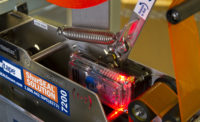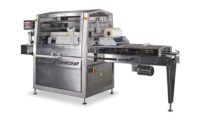Virtually everything inside a refrigerated or frozen food packaging environment is designed to perform at low temperatures — or at least it should be. Sometimes a product like carton sealing tape doesn't receive the careful consideration it requires during the purchasing process — that is, until the packaging line goes down, downtime increases or open carton complaints rise.
If your carton sealing tape isn't consistently creating secure seals, learn how choosing the right tape for your cold environment can improve line efficiency, reduce waste and create a better customer experience.
Signs Your Carton Sealing Tape Needs Attention
Meat, poultry, seafood, dairy — no matter what kind of cold or frozen product is being processed, it will, at some point, be placed in a carton and sealed for shipping and delivery to the customer. For temperature-controlled products to move swiftly through the packaging line and arrive unspoiled and intact, carton sealing tape must provide adequate adhesion and bond strength throughout the entire journey. So making purchasing decisions on price alone comes with risks that can end up costing you more in the long run. Using an inferior, low-cost tape or the wrong kind of tape in cold temperatures can result in costly consequences that can pop up anywhere along the packaging line, from carton sealing and automatic palletizing to shipping and warehousing.
Some simple ways to tell if you’re using the wrong tape include:
- Production issues. Cold temperatures can cause tapes with low-quality adhesives or the wrong types of adhesives to peel up (which is known as flagging). Once tape starts flagging, the bond can begin to break down, and the tape can fail. Flagging or failed tape can get caught in equipment and tear off, leaving carton flaps to pop open and causing slowdowns in the packaging line. In the worst cases, equipment can be damaged and require costly repairs
- Rework. When cartons aren’t successfully sealed the first time, they're often overlooked or manually reworked to correct the problem. This adds up to extra rework costs that include labor, wasted tape and additional operating energy.
- Product damage and loss. When carton seals fail further down the transit journey during shipping, receiving or warehousing, it poses the risks of product damage, contamination and theft. These conditions create costly food waste, lost products and unhappy customers.
A simple way to resolve these issues is to work with a packaging partner that can help you identify the specific needs of your carton sealing operation, then assist you in choosing a high-quality tape and applicator that matches your needs.
Cold Environment, Hot Melt
The gold standard for cold carton sealing of perishable food products is applying hot melt tape with an automated applicator. Historically, acrylic tapes were the go-to for packaging, but as automation increases its presence throughout the packaging industry, hot melt tapes have proven superior in colder environments due to their shorter dwell times, which are around 3 to 5 seconds. The instant bond of hot melt tapes and the overall strength of the bond allow these tapes to stand up to the rigors of newer automated palletizers and other high-stress shipping and handling activities without failing.
Properly engineered hot melt tapes that use a synthetic rubber/resin can be applied in temperatures as low as 20 F. This type of tape is designed to form an instant, permanent bond and can maintain its bond down to -20 F without peeling or flagging.
For packaging lines that seal heavy, bulky cartons made of recycled corrugated or recycled paper, a heavy-duty hot melt tape specifically designed for adhesion to highly recycled material is recommended. Heavy-duty hot melt tape delivers quick-sticking bond strength to create a secure, long-lasting seal and it can be applied in temperatures down to 35 F and will maintain its bond down to -20 F.
In addition to maintaining secure seals at lower temperatures, high-quality hot melt tapes can improve carton sealing efficiency and lower tape waste. To enjoy these benefits, look for a hot melt tape with a release coating that promotes consistent, low-force unwind off the roll. Easy unwinding allows carton sealing applications to operate smoothly and swiftly with fewer stops and starts and less wear and tear on equipment. It also supports full use of the roll from start to core.
Application Matters
To further improve cold carton sealing, you also need to use a dependable applicator. A quality applicator applies the appropriate wipe-down force for full adhesion and delivers accurate placement to create a reliable and repeatable seal.
Additionally, applicators with a quick-change system deliver the ability to quickly change the tape roll when it runs out — an action that can otherwise slow the process and lower productivity. Quick-change applicators are especially beneficial for high-volume operations that go through many tape rolls.
Some applicators also offer accessories that fold the tape lengthwise along the edges during application. Folded edges strengthen the tape and lower the risk of it breaking during handling and transit. They also create a safe and easy option for customers to open the case by hand instead of a dangerous box cutter.
Case Closed
High-quality hot melt tapes are purpose-built, and each is designed and engineered for a specific application environment, carton material and carton size and weight. Consulting your tape manufacturer to help you select the right tape for your refrigerated or frozen food cartons can offer several bottom-line-boosting benefits, including:
- Improving packaging line efficiency. The right tape keeps a carton sealing line running by unwinding smoothly, adhering instantly and maintaining a strong bond. The tape stays in place on the carton and keeps it securely sealed as it travels through the remainder of the palletizing, shipping and handling process.
- No wasted tape. When tape performs properly, no tape is wasted in resealing cartons. A good release coat also prevents wasted tape on startup and allows full use of the roll from start to core.
- Keeping pace with automated equipment. High-performance carton sealing tapes designed and engineered for colder temperatures require less time to form a proper seal, so an automated carton sealing area can operate at optimal speed without tape-related failures.
If your carton sealing line could benefit from a higher-quality or better-matched tape and applicator solution, consult a manufacturer with demonstrated expertise in hot melt tapes for cold sealing.
A reputable manufacturer will work directly with you to assess your operation and can even perform a side-by-side comparison of your current tape with one they recommend to demonstrate the potential operational efficiency and cost savings. Establishing a more collaborative relationship will help you select the best tape products for your needs so you can start enjoying the benefits.




